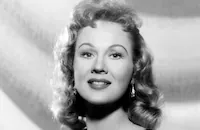Fort Utah
Brief Synopsis
Cast & Crew
Lesley Selander
John Ireland
Virginia Mayo
Scott Brady
John Russell
Robert Strauss
Film Details
Technical Specs

Synopsis
While riding through prairie country, ex-gunfighter Tom Horn meets an old friend, Indian agent Ben Stokes, and learns that the Indians have been set on the warpath by a mystery man called Dajin. The two friends spot a wagon train traveling through hostile territory without an Army escort; and while Horn joins the wagon train, Stokes heads for Fort Utah to summon troopers. Horn finds the wagon master unwilling to alarm the passengers; he remains with the group and becomes attracted to passenger Linda Lee. Stokes fails to return in 2 days, and Horn also rides off to the fort, which he finds deserted. He wanders inside and is knocked out and held prisoner along with Stokes. It is revealed that Dajin is a mutinous Army sergeant who has formed a gang of renegade troopers, murdered the fort personnel, and massacred an encampment of Indian women and children. Horn and Stokes succeed in overpowering two of the three men guarding the fort, but the third escapes to warn Dajin. Meanwhile, the Indians attack the wagon train, and the few survivors make their way to the fort. Eventually Dajin appears and begs to be saved from the marauding Indians. He is admitted but once inside attempts a double cross and is shot down. Knowing that the Indians will demand Dajin alive, Horn and Stokes strap his dead body to a saddled horse and ride through the gates of the fort with him. A volley of shots riddle Dajin's body, and satisfied, the Indians withdraw. Horn joins the wagon train on its journey westward and anticipates a bright future with Linda Lee.

Director
Lesley Selander
Cast

John Ireland

Virginia Mayo
Scott Brady
John Russell

Robert Strauss

James Craig

Richard Arlen

Jim Davis

Donald Barry
Harry Lauter
Read Morgan
Reg Parton
Eric Cody
Crew
Ralph Axness
Robert R. Benton
John Carter
Andrew Craddock
Steve Fisher
Jimmie Haskell
Paul K. Lerpae
A. C. Lyles
A. C. Lyles
Nellie Manley
Hal Pereira
Al Roelofs
Howard Roessel
John F. Schreyer
John Sturtevant
Wally Westmore
John Wilkinson
Lothrop Worth

Film Details
Technical Specs

Articles
Virginia Mayo (1920-2005)
She was born Virginia Clara Jones in St. Louis, Missouri on November 30, 1920, and got her show business start at the age of six by enrolling in her aunt's School of Dramatic Expression. While still in her teens, she joined the nightclub circuit, and after paying her dues for a few years traveling across the country, she eventually caught the eye of movie mogul Samuel Goldwyn. He gave her a small role in her first film, starring future husband, Michael O'Shea, in Jack London (1943). She then received minor billing as a "Goldwyn Girl," in the Danny Kaye farce, Up In Arms (1944). Almost immediately, Goldwyn saw her natural movement, comfort and ease in front of the camera, and in just her fourth film, she landed a plumb lead opposite Bob Hope in The Princess and the Pirate (1944). She proved a hit with moviegoers, and her next two films would be with her most frequent leading man, Danny Kaye: Wonder Man (1945), and The Kid from Brooklyn (1946). Both films were big hits, and the chemistry between Mayo and Kaye - the classy, reserved blonde beauty clashing with the hyperactive clown - was surprisingly successful.
Mayo did make a brief break from light comedy, and gave a good performance as Dana Andrews' unfaithful wife, Marie, in the popular post-war drama, The Best Years of Their Lives (1946); but despite the good reviews, she was back with Kaye in The Secret Life of Walter Mitty (1947), and A Song Is Born (1948).
It wasn't until the following year that Mayo got the chance to sink her teeth into a meaty role. That film, White Heat (1949), and her role, as Cody Jarrett's (James Cagney) sluttish, conniving wife, Verna, is memorable for the sheer ruthlessness of her performance. Remember, it was Verna who shot Cody¿s mother in the back, and yet when Cody confronts her after he escapes from prison to exact revenge for her death, Verna effectively places the blame on Big Ed (Steve Cochran):
Verna: I can't tell you Cody!
Cody: Tell me!
Verna: Ed...he shot her in the back!!!
Critics and fans purred over the newfound versatility, yet strangely, she never found a part as juicy as Verna again. Her next film, with Cagney, The West Point Story (1950), was a pleasant enough musical; but her role as Lady Wellesley in Captain Horatio Hornblower R.N. (1951), co-starring Gregory Peck, was merely decorative; that of a burlesque queen attempting to earn a university degree in the gormless comedy, She¿s Working Her Way Through College (1952); and worst of all, the Biblical bomb, The Silver Chalice (1954) which was, incidentally, Paul Newman's film debut, and is a film he still derides as the worst of his career.
Realizing that her future in movies was slowing down, she turned to the supper club circuit in the 60s with her husband, Michael O'Shea, touring the country in such productions as No, No Nanette, Barefoot in the Park, Hello Dolly, and Butterflies Are Free. Like most performers who had outdistanced their glory days with the film industry, Mayo turned to television for the next two decades, appearing in such shows as Night Gallery, Police Story, Murder She Wrote, and Remington Steele. She even earned a recurring role in the short-lived NBC soap opera, Santa Barbara (1984-85), playing an aging hoofer named "Peaches DeLight." Mayo was married to O'Shea from 1947 until his death in 1973. She is survived by their daughter, Mary Johnston; and three grandsons.
by Michael T. Toole














